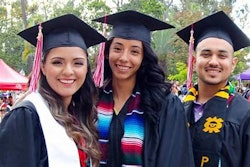Latino college students are more likely to be first-generation students and less likely to leave college having earned their degrees, according to a new report from Excelencia in Education. Emily Labandera
Emily Labandera
The April 2024 report uses publicly available data to provide readers with a “fundamental understanding” of who Latino students are, how they fit a “post-traditional student profile,” and the schools they are attending, said Emily Labandera, director of research at Excelencia.
“This is a significant college-going population,” Labandera told Diverse. “Latinos are one of the fastest growing populations and college-going populations. And if we're really thinking about ensuring America's future – whether that's the workforce, the economy, and civil leadership – Latinos are a key demographic and a key group to keep in mind when thinking about federal policy.”
Latinos in Higher Education: 2024 Compilation of Fast Facts was authored by Dr. Deborah Santiago, co-founder and CEO of Excelencia, and research analysts Dr. Cassandra Arroyo and Lily Cuellarsola.
Of the Latino students in U.S. colleges and universities, those of Mexican or Chicano descent constitute almost half (49%) of the population. Meanwhile, students of other Hispanic backgrounds made up 27%; those of Puerto Rican descent made up 12%, and those of Cuban descent 2%.
The vast majority of these students are citizens of the U.S. (90%), making their numbers comparable to students of other racial/ethnic demographics – 98% of white students and 92% of African American students. Additionally, most Latino students are second- or third-generation immigrants – 47% and 36%, respectively – meaning they were born in the U.S. as well.
When it comes to matters of postsecondary education, Latino students were far more likely than those of other demographics to be the first in the family to go to college (51%). For comparison, 31% of all students are first-generation college students, and the next highest racial/ethnic group to have first-generation students are African Americans, with 38%.
Latino students are also more likely to have enrollment statuses that are either part-time or mixed instead of full-time, with 27% each choosing to do so. And although the percentage of Latino students who reported working to pay for expenses was in line with other racial groups, it is still notable that more than half (56%) were working 30 or more hours a week to pay for school – 34% reported working 40 hours or more per week.
“They're making pragmatic choices on how to pay for their education, how to pay for college,” Labandera said.
Many Latino students require financial assistance to attend college, the report noted. Most (72%) are getting it in some shape or form, though the population receives less aid than other racial groups. In 2019-20, Latino students received an average financial aid award of $11,937, putting them lower than African Americans ($13,673), white students ($14,461), and Asians ($17,286).
However, for federal Pell grants specifically, Latino students appear to be receiving larger sums on average ($4,246) than other racial/ethnic groups, the only exception being Asians ($4,722). Around half of Latino students – and 49% of Latino undergraduates – got and made use of federal Pell grants during the 2019-20 school year, the report cited.
This need for financial aid aligns with how the families of these Latino students are doing economically, with these students’ average family incomes ($65,221) being drastically lower than the $100,000-and-above average incomes of Asian and white families.
The outcomes
Despite minor improvement in Fall 2021, rates of retention – those who come back to the same school the next year – and persistence – those who continue at any institution – among Latino students continue to trail behind national averages by several percentage points, according to the report.
Fewer of the Latino students are completing college and getting their degree than people do in general as well, demonstrating significant levels of underrepresentation when it comes to degree attainment for students of the racial/ethnic group. Just over half of all Latino college students (51%) earned a two- or four-year degree within six years, the report showed.
Attainment disparities were most pronounced regarding bachelor’s degrees, with just 13% of Latino students attaining bachelor’s degrees, compared to the 22% rate for all students. And while 44% of people, ages 18 or older, in the U.S. had received an associate degree or higher in 2021-22, only 27% of Latinos had done the same.
The schools
Most of the Latino undergrad learners (63%) are attending Hispanic-Serving Institutions (HSIs), making up almost half of HSI student bodies. The number of HSIs in the nation grows – it is now at 600 – though only 28 states have such schools, and they are usually located in cities or suburbs, the report noted.
Schools in Florida mostly topped the charts when it came to number of degrees awarded to Latino students. Florida International University, one of the U.S.’s largest HSIs, stood out for awarding the most bachelor’s and master’s degrees to Latinos for the 2019-20 school year – 8,781 and 1,844, respectively.
Miami Dade College was in the lead for the number of associate degrees awarded to Latinos – 7,388 – and Nova Southeastern University was the same for doctorates and first professional degrees – 140 and 352, respectively. Both schools are HSIs.
Dr. José Moreno, chair of California State University, Long Beach’s Chicano & Latino studies department, called the report a “reminder” to policymakers and philanthropy organizations for the need for greater investments in HSIs, which disproportionately “produce success for our Latino students.”
“The report is a continued reminder that our least resourced institutions shoulder the greatest responsibility in advancing the degree goals of Latino students,” Moreno said.
However, he also wrote that the lack of doctorates being awarded to Latino students indicated insufficient commitment from higher ed institutions to diversity their faculty ranks.
“The academe is the only industry that directly produces its own labor force, thus leading to a self-fulfilling and demoralizing cycle wherein institutions lacking in Latino faculty and executive leadership point to the lack of a pool of qualified Latinos,” Moreno said. “Yet it is institutions who admit, retain and award doctoral degrees that then make up the pool for future faculty and academic leadership.”
Although male and female Latino students graduate from high school at similar rates, gaps widened when it comes to college enrollment. As of Fall 2021, Latino males made up 40% of Latino undergrads with Latinas making up the rest.
And rates of Latino enrolling into undergraduate education as adults – ages 25 or older – are even to their white peers at 18%, the report noted.
“While we have seen progress in Latinos’ participation in higher education, a gap in degree attainment remains and there are opportunities to identify issue areas of opportunity to support and invest in the community to close those gaps,” Santiago said. “Institutions that disproportionately enroll and graduate Latino students show that intentionally serving Latino students while serving all is possible.”


















